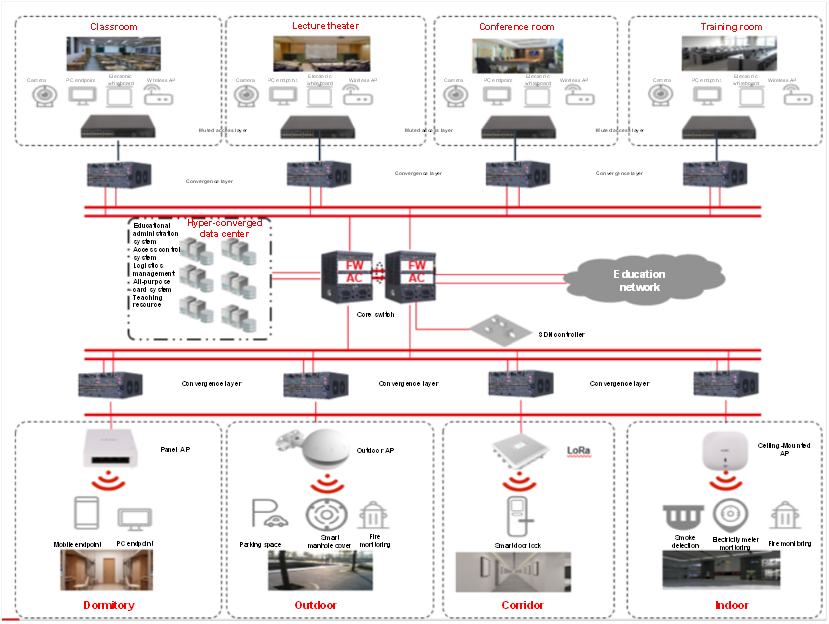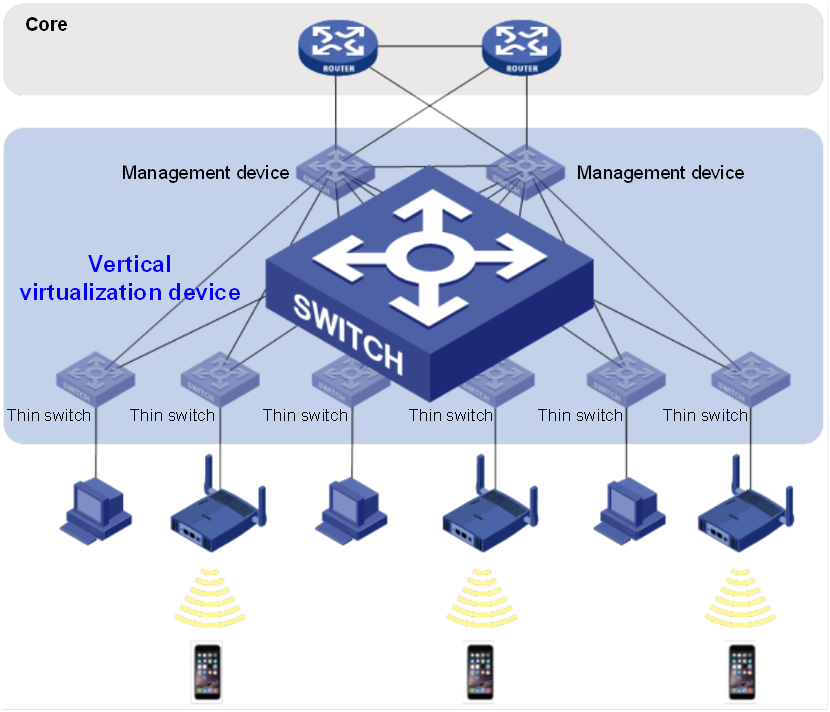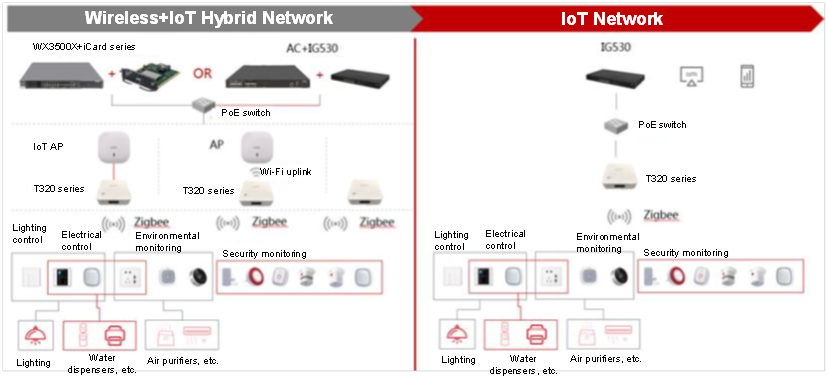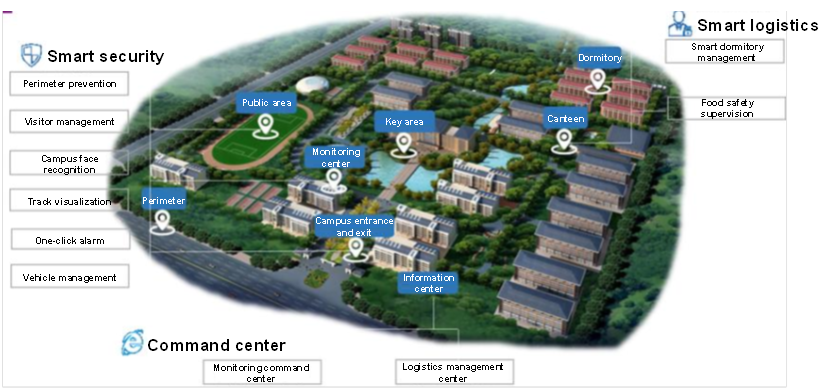Smart Campus Solution for Elementary and Middle Schools
Overall architecture

Components of the digital campus network solution
1. Converged campus network
The converged campus network mainly serves as a basic digital campus platform. The stability and reliability of the campus network have a direct impact on the normal operation of various teaching and management applications of the digital campus. For the construction of the campus network at elementary and middle schools, H3C launched the AD-Campus according to the users’ service demands. Through the deployment of SNA center, SNA controller, EIA access system, S75E/S75X switch, S5130S series switch, and Wi-Fi 6 wireless AP, users can adopt multi-service board converged solutions, including core switch board of converged security services, wireless controller board, and 10G EPON board according to actual scenarios.
2. Smart door lock solution
The smart door lock solution of H3C can achieve the intelligent management of classrooms, laboratories, dormitories, offices, and other places through LoRa devices, which can simplify the daily management of the school and monitor the real-time status of these places.
3. Converged data center
Through the deployment of the hyper-converged all-in-one product H3C UIS-Cell 3000, it is pre-installed with the outstanding hyper-converged software UIS 6.0, including computing virtualization, storage virtualization, network virtualization, and UIS manager management platform. This product also integrates the software functions of computing, storage, networking, security, O&M monitoring, cloud platform and the out-of-the-box feature. It only takes 30 minutes to build a cloud computing environment with a simple hardware architecture consisting of only servers and switches and a unified software-defined data center (SDDC) resource pool, meeting the demands of various applications at the upper layer of the digital campus.
Benefits of the digital campus network solution
1. Scenario-based solution
The solution can meet the needs of users in different scenarios. For example, the use of silent-level POE switches in the classroom can support the client access with no noise, not affecting the teacher's teaching.
Wireless APs with the PON function can be used in dormitories and offices to meet the wired and wireless access to the network at classrooms and offices, saving costs.
Ethernet access can be applied in high-concurrency user scenarios to ensure that users have sufficient uplink bandwidth, meeting the demands of users on high traffic.
(1) SDN campus network
· Three "devices": The overall network architecture of the campus network is virtualized into three levels. Each level is virtualized as a device, and the IT teacher only needs to maintain the "three" devices to manage thousands of network devices on the campus.
· "AI network administrator" freeing professionals from on-site O&M: Any network device in the subordinate school can perform self-repairing and restore its network connectivity without requiring professionals to conduct on-site maintenance in the school.
· Unchanged permissions: Leaders of the Education Department or teachers can work across campuses. The permissions of teachers and students remain unchanged in all areas. Their behaviors can be audited based on their roles.
· Hierarchical secure virtual network: A multi-layer network is built based on SDN with pooling of the underlying hardware resources, which greatly improves the network forwarding efficiency and the network speed, and enhances the network security and the quality and quantity of key services.
· Visual management: It supports a clear display of information, including the traffic and bandwidth, application types, device quantity, link status, and faulty nodes on the whole network. The end-to-end management mode improves O&M efficiency by more than 80%.
(2) Wired access solution of ES thin-client architecture

· Easy expansion
· Rapid deployment
· Easy to replace the faulty device
· Simplified network topology and reduced difficulty in management
· Low cost
(3) Wireless network of the smart campus

· Full-scenario wireless devices supporting Cloudnet: All devices on the wireless network support Cloudnet. The public cloud version is provided free of charge. It provides multiple software services, including cloud engineering survey, cloud acceptance, and Cloudnet app to make it convenient for customers to conduct network O&M.
· Full-scenario wireless devices: H3C has more than 20 wireless APs for all scenarios, including the panel-mounted, indoor, high-density, and outdoor APs.
· Imperceptible roaming: User terminals can maintain the same Internet access policy when roaming between different buildings in the school.
(4) Smart IoT classroom

· Lighting: one-click taking/finishing the class, manual & remote control, automatic adjustment according to the environment, and automatic turn-off without people's presence
· Safety: smoke, gas, carbon monoxide, water immersion, human infrared detection of intrusion, and audio and light alarm
· Electrical control: socket power supply control, socket power consumption analysis, electrical appliance switching control according to sensors, and energy saving
· Environmental monitoring: monitoring of temperature and humidity, formaldehyde, PM2.5, and PM10, and setting of the environmental adjustment strategy
· Scenario mode: fully automatic mode, mode of one-click taking/finishing the class, timing mode, and turn-off mode
· Mobile applications: device management and control, device status check, policy configuration, and device data management
(5) Smart campus

Software-defined campus scenarios
The software-defined camera boasts multiple functions and time-splitting utilization technology, adopts various types of campus smart analysis algorithms, and improves the utilization of camera resources. It achieves the unified management of the algorithm storehouse, multiple structures in one platform, and edge intelligence.
Elastic sharing of cloud-based resources
According to the Smart Campus Overall Framework (GBT36342-2018), the overall solution of the smart campus adopts the underlying architecture of virtualization in cloud computing and the idea of cloud-enabling. It can implement the rapid utilization of the underlying computing resources for data collection, aggregation, analysis, processing, and application.
Deep integration of application systems
The service application layer of the platform contains multiple functional applications to achieve diversified data access and the deep linkage of subsystems.
Lateral collaboration for emergency response
In consideration of the interconnection across systems and platforms, it conducts the horizontal collaboration on multiple application subsystems that operated independently without information exchange to achieve comprehensive management of services in multiple systems, including intelligent association. This gives full play to the application value of the system.
2. Overcoming the challenge of multiple independent service networks
The SDN solution enables the physical network to be divided for carrying the all-purpose card system and campus network at the same time, isolates various service networks from each other, and uses a unified O&M platform for unified management so that each service requires no independent network.
3. Unified O&M
It implements unified O&M of wired, wireless, SDN, and other networks without requiring an independent O&M platform for each network, greatly reducing the workload.
4. Smart door lock
The mode of "smart door lock + management application" implements fine-grained management of door locks, eliminates the regular inspection of schools, decreases the frequency of lock cylinder replacement, and reduces the operating costs of dormitories, laboratories, classrooms, and other places.
The door opening records are uploaded in real-time. It strengthens the real-time uploading of the student opening record and the safety management methods of the student apartment and improves the level of intelligence. It also provides accurate data for analysis of student portraits and behaviors, supporting the overall smart campus construction.


